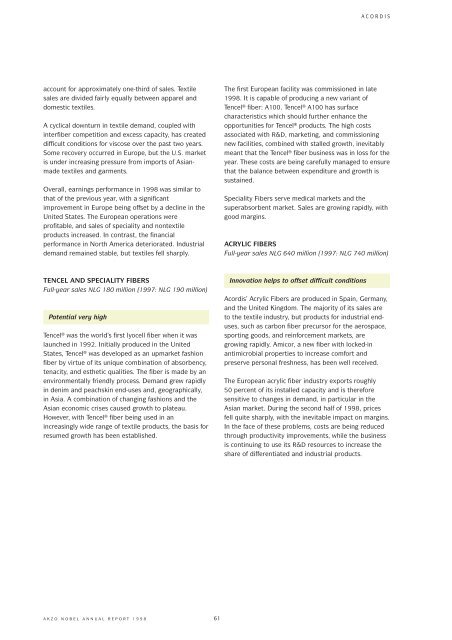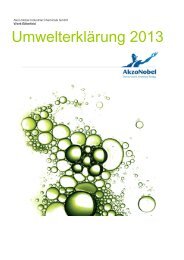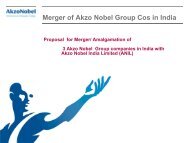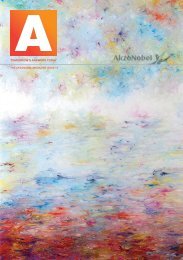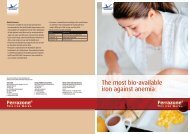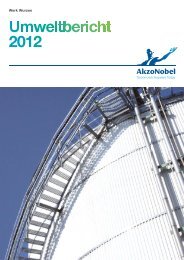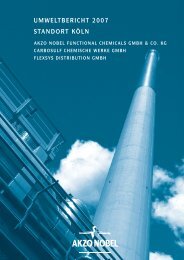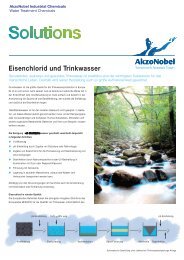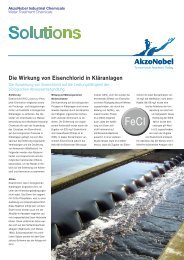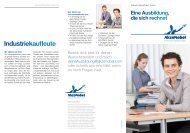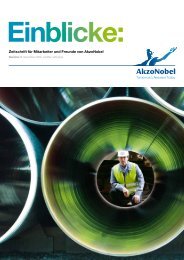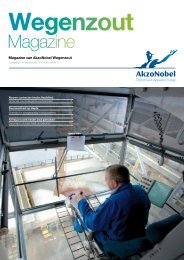You also want an ePaper? Increase the reach of your titles
YUMPU automatically turns print PDFs into web optimized ePapers that Google loves.
account for approximately one-third of sales. Textile<br />
sales are divided fairly equally between apparel and<br />
domestic textiles.<br />
A cyclical downturn in textile demand, coupled with<br />
interfiber competition and excess capacity, has created<br />
difficult conditions for viscose over the past two years.<br />
Some recovery occurred in Europe, but the U.S. market<br />
is under increasing pressure from imports of Asianmade<br />
textiles and garments.<br />
Overall, earnings performance in 1998 was similar to<br />
that of the previous year, with a significant<br />
improvement in Europe being offset by a decline in the<br />
United States. The European operations were<br />
profitable, and sales of speciality and nontextile<br />
products increased. In contrast, the financial<br />
performance in North America deteriorated. Industrial<br />
demand remained stable, but textiles fell sharply.<br />
TENCEL AND SPECIALITY FIBERS<br />
Full-year sales NLG 180 million (1997: NLG 190 million)<br />
Potential very high<br />
Tencel® was the world’s first lyocell fiber when it was<br />
launched in 1992. Initially produced in the United<br />
States, Tencel® was developed as an upmarket fashion<br />
fiber by virtue of its unique combination of absorbency,<br />
tenacity, and esthetic qualities. The fiber is made by an<br />
environmentally friendly process. Demand grew rapidly<br />
in denim and peachskin end-uses and, geographically,<br />
in Asia. A combination of changing fashions and the<br />
Asian economic crises caused growth to plateau.<br />
However, with Tencel® fiber being used in an<br />
increasingly wide range of textile products, the basis for<br />
resumed growth has been established.<br />
AKZO NOBEL ANNUAL REPORT 1998<br />
61<br />
ACORDIS<br />
The first European facility was commissioned in late<br />
1998. It is capable of producing a new variant of<br />
Tencel® fiber: A100. Tencel® A100 has surface<br />
characteristics which should further enhance the<br />
opportunities for Tencel® products. The high costs<br />
associated with R&D, marketing, and commissioning<br />
new facilities, combined with stalled growth, inevitably<br />
meant that the Tencel® fiber business was in loss for the<br />
year. These costs are being carefully managed to ensure<br />
that the balance between expenditure and growth is<br />
sustained.<br />
Speciality Fibers serve medical markets and the<br />
superabsorbent market. Sales are growing rapidly, with<br />
good margins.<br />
ACRYLIC FIBERS<br />
Full-year sales NLG 640 million (1997: NLG 740 million)<br />
Innovation helps to offset difficult conditions<br />
Acordis’ Acrylic Fibers are produced in Spain, Germany,<br />
and the United Kingdom. The majority of its sales are<br />
to the textile industry, but products for industrial enduses,<br />
such as carbon fiber precursor for the aerospace,<br />
sporting goods, and reinforcement markets, are<br />
growing rapidly. Amicor, a new fiber with locked-in<br />
antimicrobial properties to increase comfort and<br />
preserve personal freshness, has been well received.<br />
The European acrylic fiber industry exports roughly<br />
50 percent of its installed capacity and is therefore<br />
sensitive to changes in demand, in particular in the<br />
Asian market. During the second half of 1998, prices<br />
fell quite sharply, with the inevitable impact on margins.<br />
In the face of these problems, costs are being reduced<br />
through productivity improvements, while the business<br />
is continuing to use its R&D resources to increase the<br />
share of differentiated and industrial products.


